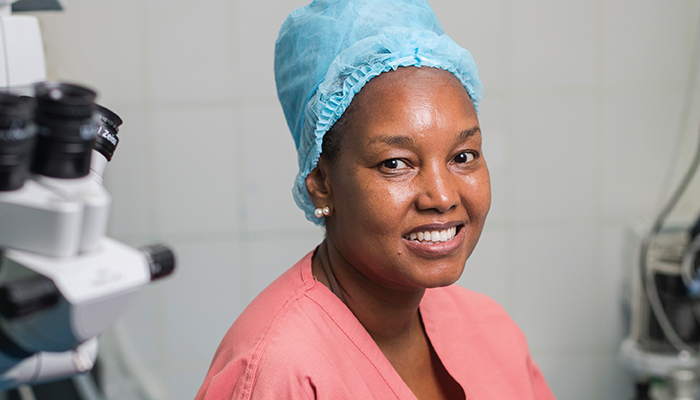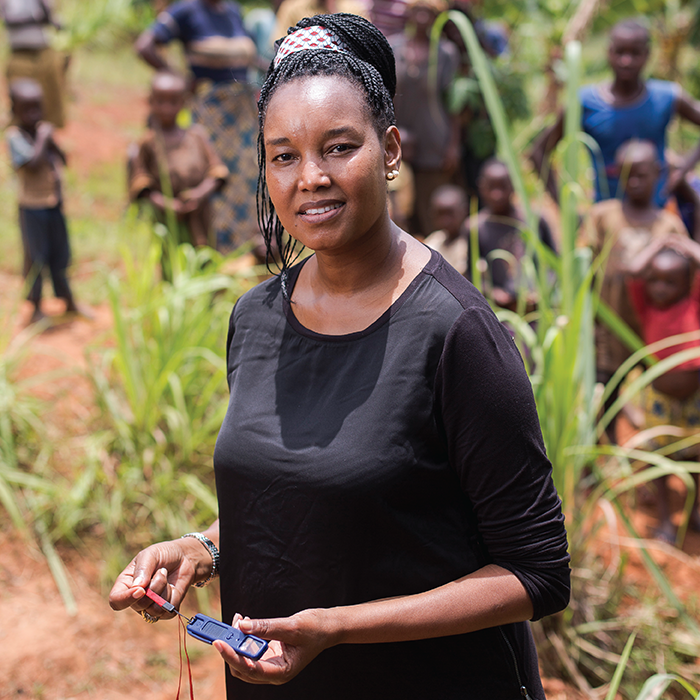
Ciku Mathenge (Credit: Images supplied by author)
As a young ophthalmologist in Kenya, I noticed that every one of my surgical lists started with male patients and ended with women. When I asked why, I was told that is how it has always been.
One day a man and his wife arrived for cataract surgery – both were blind. The man was first on the list and his wife was so far down that she didn’t receive surgery that day. Instead, she continued to look after her husband, cleaning and feeding him whle waiting for her turn on the next list.
When we discharged the man from hospital, he said he could not leave his wife there for surgery because no-one would be at home to look after him. This triggered me – I realized the tables were not equal and women would always have more to do, even if they were blind.
From that moment, women appeared on the top of my surgical list. We made the environment more supportive for female patients. And before any male patient was booked in for surgery, they were asked to bring their wives with them so they could be tested.
Globally, women account for 55 percent of people who are blind or living with a visual impairment (1). The barriers that prevent women from accessing the eye health they need must be broken down – and this is why we need more senior female leaders in health. Yet, just like female patients, female leaders are met by many roadblocks and hindrances that prevent them from having a greater say in how programs and services are delivered.
So, what can be done? The Fred Hollows Foundation has joined with UN Women to launch a policy brief to drive progress towards gender equity in health (2). World Health Organization data shows that, though women make up almost 70 percent of the global healthcare workforce, they account for less than 25 percent of the most influential leadership positions (3).
As a female ophthalmologist, I have experienced gender discrimination throughout my career. I was six months pregnant with my first child when I joined my ophthalmology residency – a situation that did not please my lecturers. One day in class, I was confronted with a difficult question. Often, the lecturers did not ask me questions but because no one knew the answer, I spoke up.
The teacher looked at my classmates and said, “You are not serious. You don’t know the answer, yet the pregnant woman knows!” At the time, I giggled and thought it was funny; only afterwards did I realize the insult.
When I requested maternity leave, I was told I would have to do another year of training to make up for the time away. I had no desire to stay in training longer than necessary. So, instead of a three-month maternity leave, I opted to take three weeks of sick leave, during which I had my caesarean section.
I vividly remember sitting on the floor four weeks after my delivery, with my back against the foot of the bed, breastfeeding my baby in one arm and making study notes with my other arm, with a determination to get to the top of the class. I succeeded, but that first year of residency was tough.
By the time I graduated, I was seven months pregnant with my second child, and this time my situation was more “acceptable.” A few months after graduation, I was pleased to learn that my experiences led to a policy shift: pregnant women in training were no longer required to train for an extra year.
These experiences stay with me, motivating me to look out for other young women, and to push for the leaders we need to ensure that no woman is left behind when it comes to eye health.

References
- GBD 2019 Blindness and Vision Impairment Collaborators; Vision Loss Expert Group of the Global Burden of Disease Study, “Trends in prevalence of blindness and distance and near vision impairment over 30 years: an analysis for the Global Burden of Disease Study,” Lancet Glob Health, 9, 130 (2021). PMID: 33275950.
- The Fred Hollows Foundation, “NO WOMAN LEFT BEHIND: CLOSING THE GENDER AND INCLUSION GAP IN EYE HEALTH.” Available at: https://bit.ly/3R8zKmT.
- World Health Organization, “Delivered by women, led by men: a gender and equity analysis of the global health and social workforce,” (2019). Available at: https://bit.ly/3sS7sVj.
